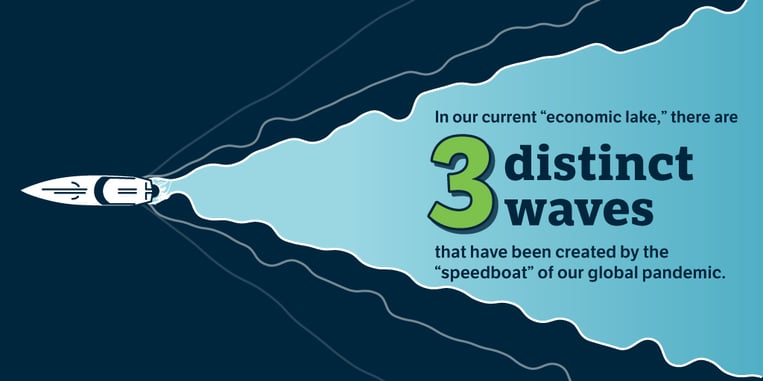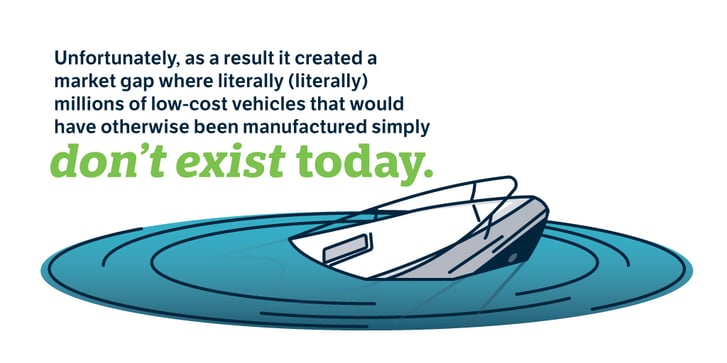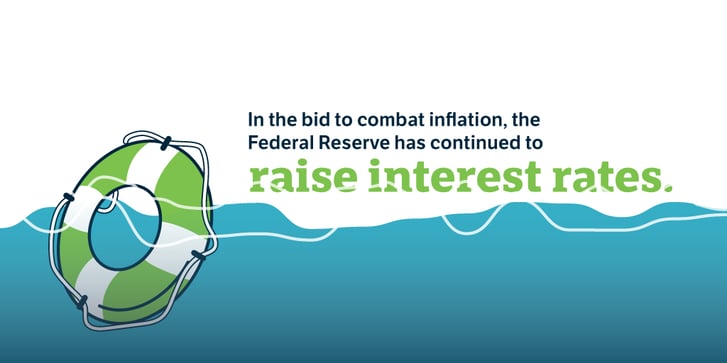Examining the Ongoing Ripple Effect of Supply Chain Disruption, Inflation, and Interest Rates
Picture the economy as a large lake, with all the economic players and stakeholders being boats on the water. Back in 2020, Covid-19 was the reckless jerk in the speedboat who just ripped across the water without regard to anything or anyone else.
Anyone who’s been a recipient of the aftermath of reckless speedboat guy knows there will be many waves that follow in his wake. Depending on your distance and the size of your own boat, these waves may threaten to swamp your craft or they may just be mild ripples in the normally calm water (hey, it’s my analogy). In addition, the direction your boat is situated, or your vector should you be underway, will also change the way your boat experiences the wake.
All that is to say that there isn’t a one-size-fits-all answer to how you will be affected by the waves.

In our economy, just like on the water, major disruptions are not over right after the trouble has passed by. In our current “economic lake,” there are three distinct waves that have been created by the “speedboat” of our global pandemic.
Wave One – Supply Chain Disruption
With the onset of Covid-19 and the shutting down of manufacturing and limiting of on-site work to “essential” personnel, the auto market changed quickly. We went from a market where car manufacturers and dealers were begging the public to buy their inventory through heavily discounted prices to a situation where the prolonged chip shortage and lack of manufacturing created empty lots and not enough vehicles to go around. As any good student of economics can tell you, the lack of supply and the excess of demand leads to higher prices.

Credit unions outperformed other financial institutions in this market, and while new car loans were a bit more scarce, the higher prices of used cars more than made up for the difference. But another ripple caused by Wave One is what car manufacturers were doing with the limited supply of chips they did have. They focused production on their high-end, higher-margin vehicles, which made them a lot of money. Unfortunately, as a result it created a market gap where literally (literally) millions of low-cost vehicles that would have otherwise been manufactured simply don’t exist today.
The impact of this missing category has just now begun to be felt in the used car market. Low-cost vehicles that we would now expect to see being traded in for new cars are just not widely available in the used car market. Those that do exist move at a high speed, staying on the market in some cases only hours. What’s a used car buyer to do? They must wait for those nicer, high-end cars to hit the market at a price they can afford, which may mean another year or two before buying.
In addition, the buyer who purchased that high-end car during the pandemic is likely to hang on to it a year or two longer to get more value from the price they paid. Manufacturers are slowly bringing back production of low-cost vehicles, but it will be years before this wave and the following ripples work their way through the economic landscape (waterscape?).
Wave Two – Inflation
As stimulus money inflated bank accounts and drove down consumer debt, and as businesses closed or limited hours, people had money to buy goods and services but limited places to spend it. More money chasing goods and services created a perfect environment for inflation to start to spiral. Groceries, energy, and cars all took significant jumps — and housing prices, especially, escalated steeply. During the height of the run-up, in many places, when selling a house it was not uncommon to get multiple cash offers for significantly more than list price in a matter of days. Renters also felt (and still feel) the bite of inflation as their leases renew at significantly higher rates.
As inflation continues to be an issue, many households have moved from having to decide how to spend their extra dollars to instead having to decide which bills will get those dollars. As a result, lenders are back in the full swing of collections as delinquencies rise. Unfortunately for lenders, an increasing delinquency rate can move quickly into increased charge-offs.
The inflation wave is just now being felt in the lender space and the expectation is that 2023-2024 will be challenging to the bottom lines of many lenders. Staffing shortages combined with salary inflation, combined with more demand for repossession, skip tracing, and remarketing services than market supply currently provides, leads to anecdotal stories of lenders spending extra money to have their vehicles bumped in priority so they won’t be left out.
It doesn’t take long for all of these forces to combine to create a new higher price point for everyone — and so inflation continues.
 Wave Three – Interest Rates
Wave Three – Interest Rates
In the bid to combat inflation, the Federal Reserve has continued to raise interest rates. Rates climbed steeply from 3.25% to (at the time of this writing) 8.00% in the space of less than a year. While the rate of increase has started to taper off, the impact is undeniably being felt in many areas.
In the housing market, lending has cooled significantly as:
-
Refinance activity has virtually dried up.
-
Inflated home prices plus significantly higher mortgage rates have priced many buyers out of the market altogether.
Similarly, in the auto market:
-
Buyers who would normally trade in their vehicles for a new one are looking at either a huge increase in the monthly payment amount or a one- to two-year extended term on the note.
-
Many of those buyers are deciding to hang on the vehicle they have.
-
For those borrowers who do take the plunge, even small changes in their economic reality could lead to delinquencies, defaults and repossessions — making the risk much higher for their lenders.
Historically, the labor market has to tighten significantly in order to rein in inflation. That hasn’t happened yet. The Fed is being cautious in an attempt to not make that a reality, but it remains to be seen. The impact of this wave has shifted the water line, but stay tuned for more turbulence.
Naturally, all boats aren’t the same size, the same design, or heading in the same direction. Each lender has to examine their own unique boat to determine the best way to position it to ride out the waves and hopefully return to calmer waters — at least until the next jerk in a speedboat comes along to stir things up.
For a personalized consultation regarding ways we can help your financial institution ride out this storm with reduced risk, reduced charge-offs, and greater peace of mind, contact our CPI experts.




